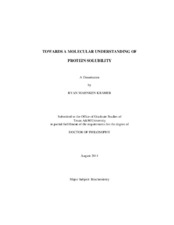| dc.description.abstract | Protein solubility is a problem for many protein chemists including structural biologists and those developing protein pharmaceuticals. Knowledge of how intrinsic factors influence solubility is limited due to the difficulty in obtaining quantitative solubility measurements. Solubility measurements in buffer alone are difficult to reproduce, as gels or supersaturated solutions often form, making the determination of solubility values impossible for many proteins. Protein precipitants can be used to obtain comparative solubility measurements, and they fall into three broad classes: salts, long-chain polymers, and organic solvents.
Our group has used a model protein, RNase Sa, to create 20 variants that differ by the residues at a single surface-exposed position. We have measured the protein solubility of these variants and have generated an amino acid solubility scale, in the context of a protein, measured in ammonium sulfate. Here, we present solubility scales for these variants using PEG-8000 and isopropanol as precipitants. We find that amino acids can be divided into three groups based on their contribution to protein solubility: those that increase protein solubility, those that decrease protein solubility, and those that show little change in protein solubility as compared to our wild-type protein which has a threonine at the variable position. Of the 20 variants used here, the aspartic acid, glutamic acid, and serine variants show the greatest increases in protein solubility. Based on our results, we propose a strategy for increasing protein solubility: substitute exposed hydrophobic, asparagine, glutamine, and threonine residues with aspartic acid, glutamic acid or serine. To test this hypothesis, we utilize this strategy on a low solubility variant of RNase Sa.
Here, we compare the use of representatives from two classes of precipitants, ammonium sulfate and polyethylene glycol 8000, by measuring the solubility of seven proteins. We find that increased negative surface charge correlates strongly with increased protein solubility and may be due to strong binding of water by the acidic amino acids. We also find that the solubility results obtained in the two different precipitants closely agree with each other, suggesting that the two precipitants probe similar properties that are relevant to solubility in buffer alone. | en |


